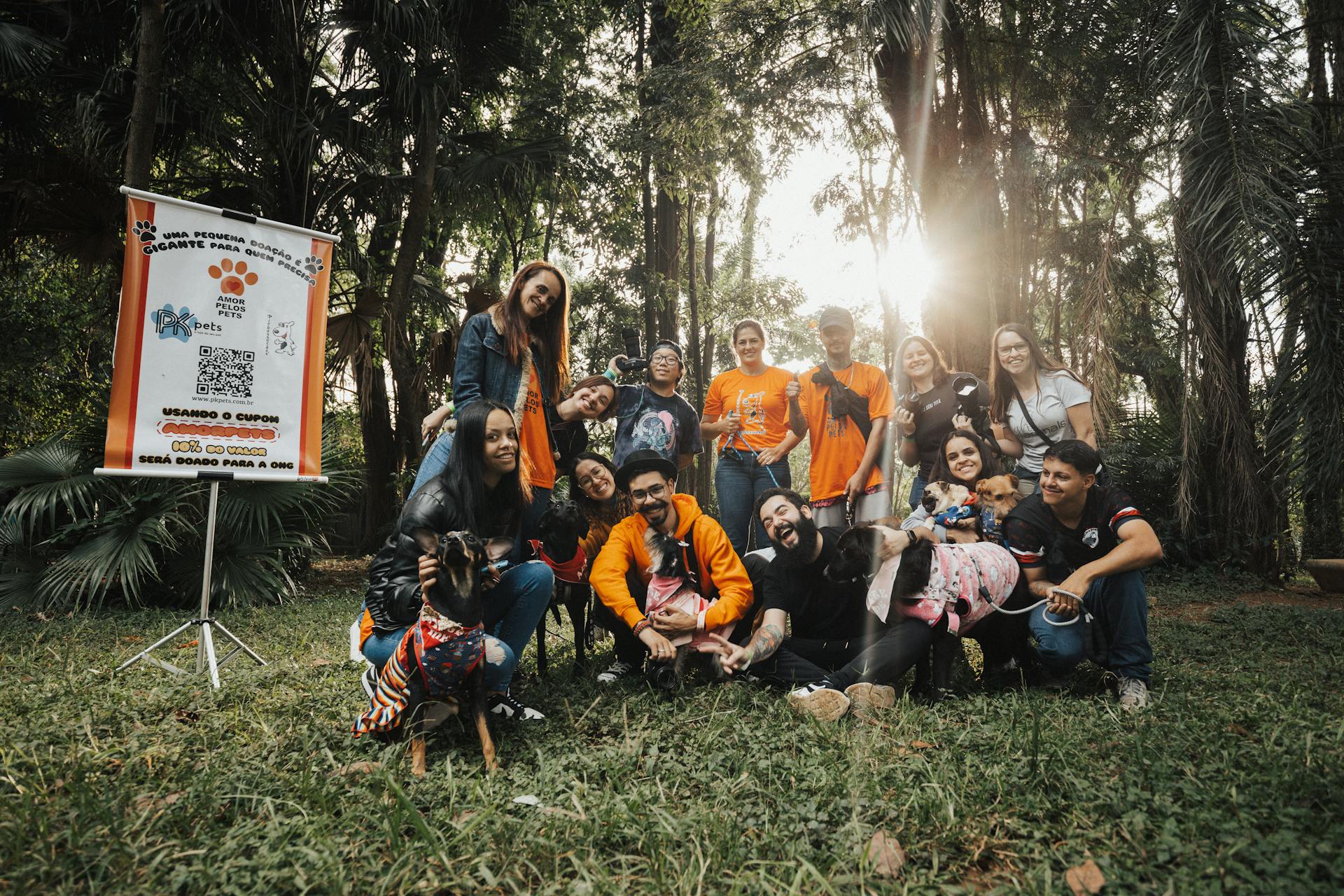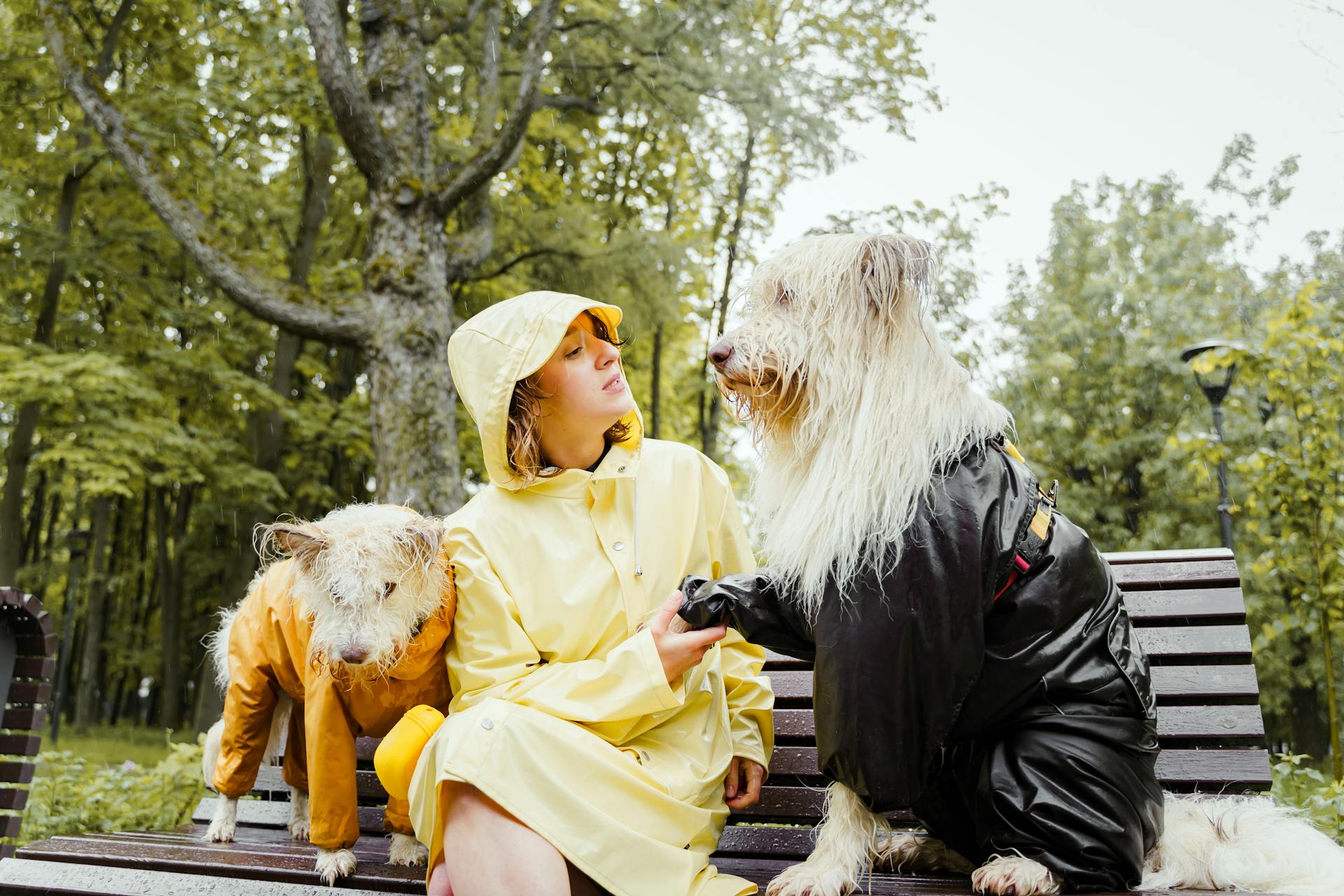
Adopting a dog can be a life-changing experience, but it's essential to know the step-by-step process involved. You can start by contacting a local animal shelter or rescue group to express your interest in adopting a dog.
The shelter will ask you to fill out an adoption application, which typically includes questions about your lifestyle, living situation, and experience with dogs. This is to ensure you're a good match for a dog's needs.
You'll also need to provide identification and proof of residency, which is usually a requirement for the adoption process. This helps the shelter verify your information and ensure you're a responsible pet owner.
Once your application is approved, you'll be able to meet with an adoption counselor to discuss your preferences and find a dog that's a good fit for you.
Before Bringing Your Dog Home
Before bringing your dog home, it's essential to prepare your space to ensure a smooth transition for both you and your new furry friend. Determine where your dog will spend most of his time, as he may forget housebreaking skills due to stress from the change of environment.
A kitchen often works best for easy clean-up, so consider setting up a dog-friendly area there. If you plan on crate training, have a crate ready to go for when you bring your dog home.
Dog-proofing is crucial, especially during the first few months. This means taping loose electrical cords to baseboards, storing household chemicals on high shelves, removing plants, rugs, and breakables, setting up the crate, and installing baby gates.
To avoid confusion and help your dog learn commands more quickly, create a vocabulary list with everyone who will be interacting with your dog. This will help prevent confusion and ensure a faster learning process.
Don't forget to bring an ID tag with your phone number on it when you pick up your dog, providing an extra measure of safety for the ride home and the first few uneasy days. If your dog is microchipped, register your contact information with the chip's company to ensure you can be reached if your dog gets lost.
You might like: When You Lie down with Dogs?
Other Dogs at Home?
If you already have a dog in your home, introducing a new dog can be a bit more complicated.
Much of what we discussed above applies to both dogs, so you'll want to consider their individual needs and personalities.
If you're bringing a new dog home, a great step by step guide to introducing dogs can help make the process smoother.
You'll want to pay close attention to body language and behavior, especially in the first few interactions.
If this caught your attention, see: Why Do You Want to Adopt a Dog?
Keep Them Longer
If you plan to rehome your dog through friends, family, or other outlets, it can take a lot more time.
You might be looking at weeks or months while you hunt for their furever home.
This strategy may not be feasible if the dog is aggressive towards you or others.
In emergency situations, rehoming quickly is the best option.
Dog Adoption Process
As you consider adopting a dog, it's essential to screen potential adopters carefully. You might be eager to find a new home for your dog, but rushing the process can lead to a bad match.
Ask potential adopters questions about their experience with dogs, their living situation, and their daily schedule. This will help you determine if they're a good fit for your furry friend.
Finding the right home for your dog takes time and patience, but it's worth it to ensure they'll be happy and well cared for.
Screen Adopters
Screening potential adopters is a crucial step in the dog adoption process. You want to find the best possible home for your furry friend, so don't rush into anything. Ask potential adopters questions about their experience with dogs, their living situation, and their daily schedule to get a sense of their lifestyle.
Find out how comfortable they are with a particular breed or mix of breeds. This will help you determine if they're a good match for your dog. You might also consider asking about their experience with dogs of similar size, energy level, and temperament.
Knowing how often they'll be able to take their dog for walks and playtime will also help you gauge their suitability. Ask about their work schedule, travel plans, and other factors that might impact their ability to care for a dog. This will give you a better understanding of their lifestyle and whether it's a good fit for your dog.
Transfer Ownership
Transferring ownership of your dog to the new owner is a crucial step in the adoption process. Make sure to update your dog's registration and license with the county.
You'll also need to update your dog's microchip information with the new owner's contact details. If you don't remember the microchip number, ask your vet to scan it for you.
Update your pet insurance provider with the new owner's information, if you have one. This will ensure your dog continues to receive the care they need.
Return your dog's tags and collar to the new owner, so they can identify your dog and keep them safe.
It's essential to notify your veterinarian about the change in ownership. They'll need to update your dog's records and transfer them to the new vet, if necessary.
Intriguing read: What to Do with Your Dog's Ashes?
Dog Adoption Fees
Dog adoption fees vary from shelter to shelter, but they typically cover most of the veterinary costs to prepare your new pup for its new home.
The adoption fee usually includes a wellness exam, vaccinations, heartworm test and treatment, tick-borne disease panel, flea and tick preventative treatment, fecal test and deworming, spaying or neutering, microchipping, and a small administrative fee.
Some shelters may include additional perks, like pet insurance, as a thank you for adopting a dog. For example, Second City Canine Rescue in the Chicago area includes 30 days of pet insurance from 24PetWatch.
You'll need to ask the shelter or rescue what's included in their adoption fee before finalizing the adoption, as the details may differ.
Rehoming Fees
Rehoming fees can be a tricky topic. Some owners may ask for a rehoming fee to cover costs like vet bills and food, but it can also be a way for unscrupulous breeders to make a profit.
Backyard breeders and owners may use rehoming fees to make a profit off of a dog they've bred, especially if they claim the dog is purebred and are asking for a steep fee.
A rehoming fee can also be a way to ensure the new owner is serious about caring for a dog, but it should never be the deciding factor in who gets the dog.
If you're rehoming a dog due to financial hardship, a new owner may be willing to help make up the difference, but this should be a last resort.
Ultimately, a rehoming fee should be used to help the dog find a safe and loving home, not as a way to make money.
Dog Adoption Fees
Dog adoption fees can vary depending on the shelter or rescue, but most cover a significant portion of the veterinary costs to prepare your new pup for a happy home. The adoption fee typically includes a wellness exam, vaccinations, heartworm test and treatment, tick-borne disease panel, flea and tick preventative treatment, fecal test and deworming, spaying or neutering, microchip, and a small administrative fee.
Some shelters may include additional perks, such as 30 days of pet insurance, as a thank you for giving a dog a new home. For example, Second City Canine Rescue in the Chicago area includes 30 days of pet insurance from 24PetWatch.
The adoption fee does not typically include supplies you'll need for your new pup, such as a leash and collar, toys, crate for training, food and water bowls, poop bags and dispenser, training pads, and treats. You'll also need to consider food for your new pup, and it's a good idea to ask the shelter or rescue what food your dog has been eating so you can stick to the same food or slowly transition to another.
Here's a list of basic supplies you'll need for your new pup:
- Leash and collar
- Toys
- Crate for training
- Food and water bowls
- Poop bags and dispenser
- Training pads
- Treats
It's also a good idea to have both dry and wet food on hand in your first days together, as your new pup may be nervous and not want to eat the first few days.
What to Expect
Adopting a dog can be a life-changing experience, and it's essential to know what to expect.
The first step is to choose an adoption method that suits you best, whether it's through a shelter, rescue group, or reputable breeder.
You'll typically need to fill out an adoption application, which will ask for information about your lifestyle, living situation, and experience with dogs.
The application process usually takes a few days to a week, and it's a great opportunity to ask questions and learn more about the dog you're interested in.
You'll also want to prepare your home by dog-proofing and setting up a safe space for your new furry friend.
The adoption process typically includes a meet-and-greet with the dog, which allows you to assess compatibility and ensures the dog is a good fit for your family.
Once you've adopted your dog, you'll need to schedule a veterinary visit within the first few days to ensure they're healthy and receive any necessary vaccinations.
This initial veterinary visit will also give you a chance to ask questions and get advice on caring for your new dog.
The first few weeks with your new dog will be a time of adjustment, but with patience and love, you'll be well on your way to building a strong bond.
Frequently Asked Questions
What is the 3-3-3 rule for rescue dogs?
The 3-3-3 rule is a guideline for introducing a rescue dog to its new home, consisting of 3 days for adjustment, 3 weeks for training and bonding, and 3 months for socialization and continued training. This structured approach helps ensure a smooth transition for both dog and owner.
What is the hardest part of adopting a rescue dog?
The hardest part of adopting a rescue dog is dealing with their unknown past and adapting to a new environment. This requires patience and consistent training to help them learn good behavior.
Sources
Featured Images: pexels.com


